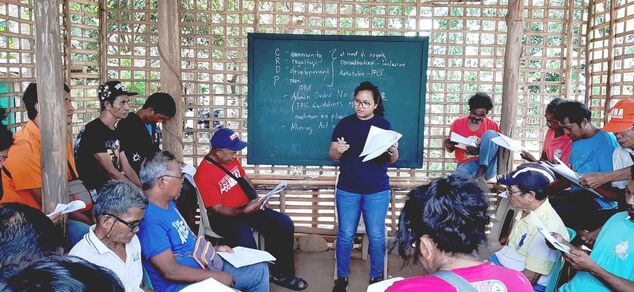|
Blog by Rose Ann Marie Paragas When we talk about empowerment of people, I always remember a professor and a mentor back in college who always remind us to define first what empowerment is. The Google dictionary would tell us that it is “giving power or authority to someone to do something”. Prior to that, other important questions would be: Who defines empowerment? Who empowers who? And, how does one promote empowerment? This has been the principle that caused carefulness, at least in my own journey as a project implementer, of the two-year Voice project entitled “Claiming Political Space: Amplifying Voices of Indigenous Peoples in Minerals Management”. With a quick glimpse of the project, I would assume that the empowerment we’re trying to achieve is to claim that political space which is probably lacking or limited among indigenous peoples – to allow them to meaningfully participate in decision making in the management of their minerals. One of the objectives of the project is to craft their Community Royalty Development Plan (CRDP) using an inclusive and participatory approach. The CRDP is a plan on how to manage the royalties received from mining operations, and prioritizing programs to which the indigenous community led by the Indigenous Peoples Organizations and/or the Indigenous Political Structure, shall allocate the funds. Supposedly, their CRDP should be based on their Ancestral Domain Sustainable Development Plans (ADSDPP). Consequently, the ADSDPP is a prerequisite for the indigenous groups to acquire a Certificate of Ancestral Domain Title (CADT). My experience at the community level allowed me to validate these assumptions. To start, it is important to establish that the indigenous peoples and indigenous cultural communities define what is empowerment for them. There is already power within them that only needs to be awakened and strengthened. This is primarily our role as development workers to facilitate such an awakening of spirit by journeying with them and for them.
This definition of empowerment goes beyond merely having a Community Royalty Development Plan (CRDP). To them, empowerment roots back to exercising self-determination over their ancestral domain, the whole spectrum of natural resource governance and the indigenous processes within their land. It is for this reason that in planning, the IP groups considered not only royalties from mining but from all other resources within the domain. To achieve this though, the IPs are faced with challenges that are internal to the group as well as external challenges that may be due to the lack and/or gaps in government policies and guidelines. Consequently, these challenges also need reconciliation of both internal and external controls and interventions to be addressed. In the case of Luzon particularly in Benguet and Palawan, it is safe to say that the indigenous peoples do have a political space or a platform to amplify their voices on minerals management and natural resource governance. There are existing Indigenous Peoples Organizations (IPO) whose members are supposedly part of the Indigenous Political Structure (IPS). Note that there is a need to establish the distinction between the two among IPs and ICCs. The IPS also designates the Indigenous Peoples Mandatory Representative (IPMR) in the local government units both at the barangay and municipal level. However, it was made apparent that these platforms need to be strengthened and/or widened. Achieving such a result includes reliving the IP Identity and the consciousness as individuals that work together as one unit united by their relationship to their land and their ancestors. One of the essential keys in strengthening such platforms is the installment of clear guidelines and policies from relevant government agencies, alongside, the support of civil society organizations in providing assistance for collaborative learning and education. At present, some IPs are not yet awarded with their Certificate of Ancestral Domain Titles (CADT). This is oftentimes due to the lack of the Ancestral Domain Sustainable Development and Protection Plan (ADSDPP). The creation of such a document needs resources which may be the main challenge among IP groups, such that of the Tagbanua and Palaw’an Tribe in Narra, Palawan. This also makes it even more challenging to craft a Community Royalty Development Plan (CRDP) which as per the guideline of the National Commission on Indigenous Peoples (NCIP) should be based on the ADSDPP. Even guidelines on CRDP is not in place at present. Having said these things, we know for a fact that there is so much work left for all stakeholders involved: the IPs, the government, the civil society, and other players. Dreaming about the empowerment of indigenous peoples in minerals management, collaborative actions must be done while still putting the interest of the IPs at the center of every decision making by allowing their voices to be heard and amplified.
0 Comments
|
Previous Posts
May 2024
Topics
All
|
What We Do |
Know More |
About Us |
Contact Us
[email protected] | +(63) 917 5105 879 1402 West Trade Building, West Avenue, Brgy. Phil-Am, Quezon City, Philippines |

